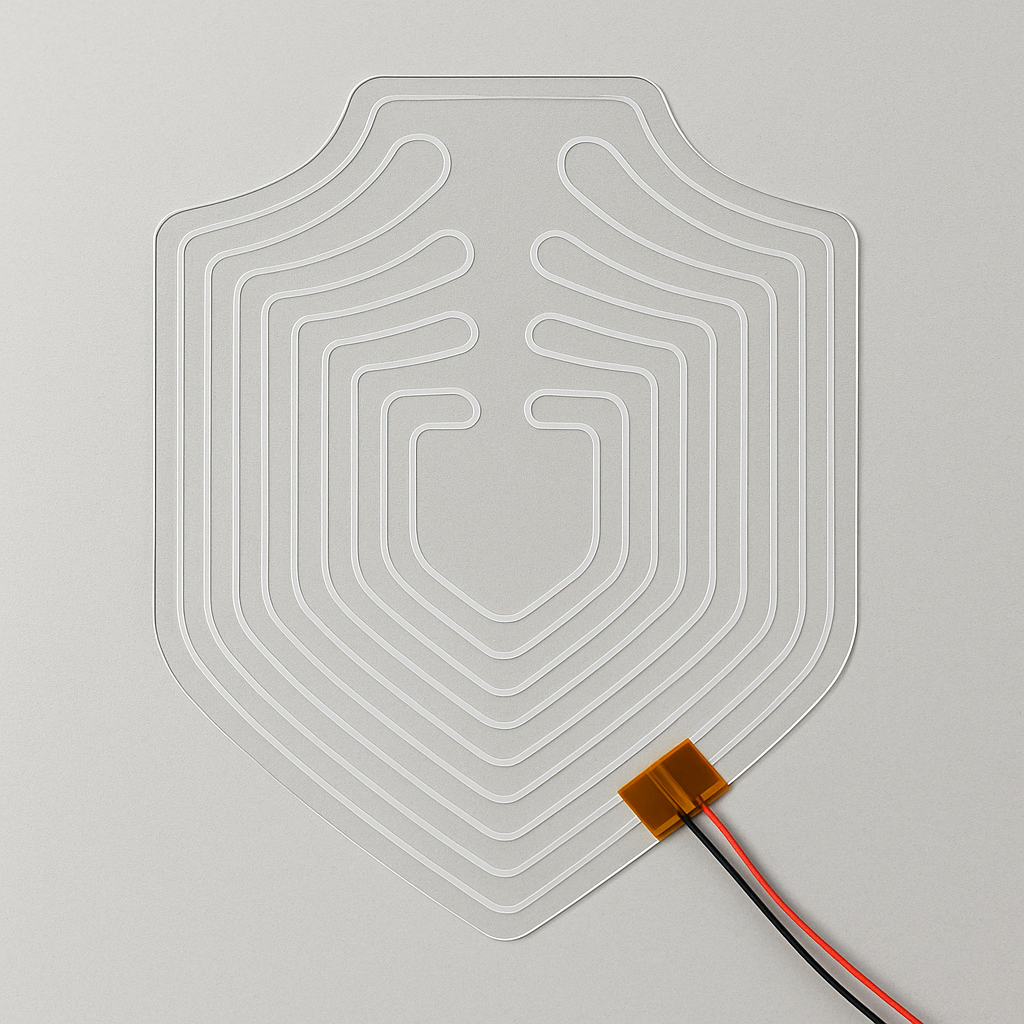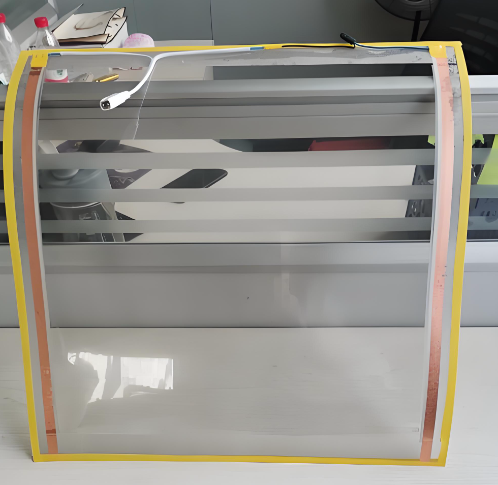Fog and moisture can stop a camera, block a display, or slow down production within minutes. When this happens, the project risks delays, extra labor, and unexpected rework. To avoid these problems, engineers and buyers now rely on custom-shaped optically clear heaters.
For buyers and sourcing teams, the real challenge is not understanding what a transparent heater is—it is choosing the right optically clear heater manufacturer that can deliver stable quality, fast lead time, and long-term supply. This guide explains how these heaters work, why shaped heaters are difficult to produce, what affects cost, and why choosing the right supplier makes or breaks your project.

An optically clear heater is a thin transparent heating layer laminated onto glass or film. It prevents fog, condensation, or frost on:
The heater warms the surface using transparent conductive materials such as ITO, silver mesh, nanowire, or CNT. Because the layer is almost invisible, it does not block light or reduce image quality. The goal is simple: keep visibility stable in cold, humid, or wet environments.
Typical Performance Range
| Parameter | Typical Value | Notes |
| Transparency | 88% – 92% | Higher for camera-grade PET |
| Haze | <1% | Important for image clarity |
| Heating time | 3–10 seconds | Depends on power density |
| Operating temperature | -40°C to +85°C | Suitable for outdoor cameras |
| Sheet resistance | 12–300 Ω/sq | Adjusted based on power needs |
While standard square or rectangular heaters are common, custom-shaped optically clear heaters require specialized manufacturing technology. Many suppliers cannot meet these requirements due to:
1. Complex Patterning on Transparent Conductive Films
Transparent conductive coatings must be etched or laser-patterned without damaging optical clarity.
2. Maintaining Heating Uniformity in Irregular Shapes
Odd shapes (rings, arcs, trapezoids, asymmetrical windows) often create uneven resistance paths. Only experienced manufacturers can design uniform heating.
3. Tight Tolerances for Optical Applications
Industries like automotive or medical devices require:
4. Challenges in Lamination and Adhesion
Bonding optically clear adhesives (OCA) without bubbles is a specialized skill, especially with curved or large parts.
5. Strict Environmental Reliability Standards
Custom heaters often must pass:
Only a handful of optically clear heater manufacturers worldwide can deliver all these simultaneously.

These heaters are widely used where condensation directly affects visibility or safety.
| Industry | Common Use | Why Heater Needed |
| Security & Smart City | CCTV dome, PTZ cameras | Night-time fog, winter frost |
| Automotive ADAS | Lane assist, parking cameras | Snow, humidity, cold starts |
| Drones / UAV | Flight cameras, sensors | Rapid temp changes during flight |
| Medical | Imaging windows, displays | Temperature-controlled rooms |
| Food Factory | Observation windows | Steam, high humidity |
| Cold Chain | Inspection windows | Defogging in low temperature |
| Marine | Navigation lenses | Salt spray + humidity |
Most buyers ask for uncommon shapes due to device structure. Below are the shapes that we had made for our customers:
These shapes need careful pattern design so current flows evenly without bright spots.
If you had requested a quotation from a flexible heater manufacturer, you may know the prices of heaters are much higher than flexible circuits. Do you know why? Actually, cost depends on materials, complexity, and inspection requirements. Here is a simple table that explains the main cost factors buyers care about.
| Factor | How It Impacts Cost |
| Material type | ITO glass costs more than PET; PET costs more than metal mesh |
| Shape complexity | More curves, holes, or thin arms require harder patterning |
| Size | Larger surfaces use more material and more energy |
| Clarity target | High transparency and low haze need stricter control |
| Power density | Higher watt density needs stronger pattern precision |
| Connector style | Custom FPC or solder pads increase process steps |
| Lamination layers | Extra OCA or glass raises cost |
| Inspection level | Camera inspection and optical grading add cost |
| Order volume | Small orders have higher per-piece cost |
Please note: for all heaters, simple square shapes and standard shaped heater always cost much less than custom irregular outlines. And the smaller the dimension, the higher the price.
Choosing the wrong supplier can slow your project and increase cost. The right factory should support engineering work, quality control, and full customization.
1. Look at clarity performance
Ask for their transmittance, haze range, and test method. A strong vendor usually provides 90% transmittance
2. Check their patterning and shape capability
Verify whether they can support inner holes, long wires, curved edges, and asymmetric outlines. Many vendors cannot handle fine heating traces on unusual shapes.
3. Evaluate bonding and OCA lamination skills
Improper bonding can cause bubbles or Newton rings. A capable manufacturer controls cleanliness, pressure, and alignment during lamination.
4. Review insulation and reliability data
Important tests include:
5. Ask about engineering support
A good partner should offer:

Danyu Electronics works with transparent heaters for camera, display, sensing, and industrial needs. Our strength comes from experience with custom-shaped optically clear heater production and strong engineering support. Here are reasons of what makes us different:
We also work with global OEMs in security, medical devices, and industrial equipment. Our factory keeps stable quality and clear documentation through every stage.
| Item | Specification |
| Maximum Finished Panel Size | 600 × 2000 mm |
| Minimum Finished Panel Size | 20 × 20 mm |
| Substrate Thickness | 0.2–1.0 mm |
| Transparent Double-Sided Adhesive Thickness | 55 μm |
| OCA Adhesive Thickness | 50 μm, 125 μm |
| Electrodes | 1. Minimum edge clearance for copper foil: ≥ 2 mm 2. Minimum edge clearance for silver paste: ≥ 0.5 mm 3. Typical copper foil width: ≥ 3 mm (5 mm / 10 mm common) 4. Typical silver paste width: ≥ 2 mm |
| Resistance Tolerance | ±10%–20% (customizable per request) |
| Power Tolerance | ±10%–20% (customizable per request) |
| Maximum Power Density | 0.15 W/cm² (depends on substrate and limit) |
| Temperature Range | –40°C to +100°C; Recommended long-term ≤ 90°C |
| Voltage Range | 0–220V |
| Visible Light Transmittance | 80%–90% |
| Surface Hardness | PET surface hardness: 3H |
| Haze | < 3% |
Q: Can you make any custom shape transparent heater?
A: Yes — rings, ovals, C-shapes, narrow borders, large-area windows, even free-form outlines. We accept shape files (DXF or PDF) and deliver precise heaters.
Q: What is the typical lead time for samples?
A: About 7–12 days for prototypes, depending on complexity. After approval, mass production lead time is typically 2–4 weeks.
Q: Which materials do you provide?
A: ITO PET, ITO glass, silver mesh, nano-wire — selected based on clarity, flexibility, heating requirements.
Q: Do you support optical bonding in cleanroom?
A: Yes. We bond in cleanroom conditions, ensuring no dust, bubbles or haze — even for thin or curved substrates.
Q: Can you support small-batch orders?
A: Yes. We accept small volumes before ramping to large OEM orders — no rigid MOQ constraints for many designs.
Q: Are these heaters suitable for automotive or medical use?
A: Yes. We hold ISO9001, ISO13485, AS9100D and support material/certification requests for automotive, medical, industrial projects.
Q: What if the heater fails after installation?
A: We offer post-sale support, including quality check, failure analysis, and replacement under warranty for qualified faults.
Danyu Electronics offers one-stop flexible heaters manufacturing from custom-shaped transparent heaters to full quality control and after-sales support, we help you reduce risk, avoid rework, and keep your optical devices clear — not just at start, but over their full lifecycle.
Simply drop your email or phone number in the contact form, and we'll promptly reply you shortly.